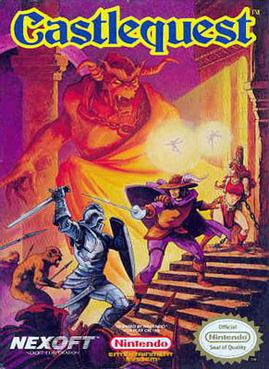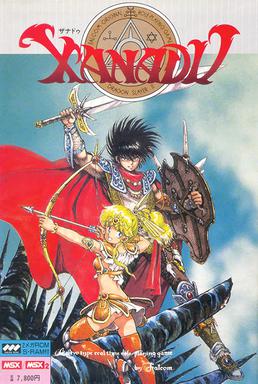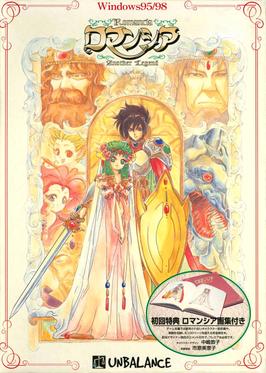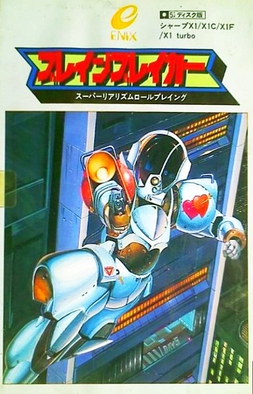
Gradius is a side-scrolling shooter video game developed and published by Konami. The first game in the Gradius series, it was originally released as a coin-operated arcade game in 1985. The player maneuvers a spacecraft known as the Vic Viper that must defend itself from the various alien enemies. The game uses a power-up system called the "power meter", based upon collecting capsules to purchase additional weapons.

The X68000 is a home computer created by Sharp Corporation. It was first released in 1987 and sold only in Japan.

The PC-8800 series, commonly shortened to PC-88, are a brand of Zilog Z80-based 8-bit home computers released by Nippon Electric Company (NEC) in 1981 and primarily sold in Japan.

Castlequest is an adventure video game. It was developed and published by ASCII Corporation in 1985 for the FM-7, PC-88, and Sharp X1. Additional versions followed in 1986 for the Famicom and MSX, and was subsequently released in 1989 for the NES in the United States by Nexoft Corporation.

Bomberman is a maze video game developed and published by Hudson Soft. The original home computer game Bomber Man was released in July 1983 for the NEC PC-8801, NEC PC-6001 mkII, Fujitsu FM-7, Sharp MZ-700, Sharp MZ-2000, Sharp X1 and MSX in Japan, and a graphically modified version for the MSX and ZX Spectrum in Europe as Eric and the Floaters. A sequel, 3-D Bomberman, was produced. In 1985, Bomberman was released for the Nintendo Entertainment System. It spawned the Bomberman series with many installments building on its basic gameplay.

The X1, sometimes called the Sharp X1 or CZ-800C, is a series of home computers released by Sharp Corporation from 1982 to 1988. It is based on a Zilog Z80 CPU.

Bokosuka Wars (ボコスカウォーズ) is a 1983 action-strategy role-playing video game developed by Kōji Sumii (住井浩司) and released by ASCII for the Sharp X1 computer, followed by ports to the MSX, FM-7, NEC PC-6001, NEC PC-8801 and NEC PC-9801 computer platforms, as well as an altered version released for the Family Computer console and later the Virtual Console service. It revolves around a leader who must lead an army in phalanx formation across a battlefield in real-time against overwhelming enemy forces while freeing and recruiting soldiers along the way, with each unit able to gain experience and level up through battle. The player must make sure that the leader stays alive, until the army reaches the enemy castle to defeat the leader of the opposing forces.

Stop the Express (also known as Bousou Tokkyuu SOS is a video game developed by Hudson Soft and published in 1983. It was written for the Sharp X1 and later ported to the ZX Spectrum, Commodore 64, and MSX.
The Sharp MZ is a series of personal computers sold in Japan and Europe by Sharp beginning in 1978.
System Sacom (システムサコム), also known as System Sacom Sales Corp., is a Japanese company which sells electronic devices. They are more notable for their past, in which they developed video games. In the 1980s, they mainly published games for computers, but they changed focus to home consoles in the 1990s. Its head office is located in Tokyo.

Binary Land is a puzzle video game developed by Hudson Soft in 1983 for the MSX, FM-7, PC-6001mkII, NEC PC-8801, Sharp MZ-2200, Sharp MZ-5500, Sharp X1 and in 1985 for the Famicom. The MSX version saw release in Japan by Hudson Soft and in Europe by Kuma Computers Ltd in 1984.

Hydlide is an action role-playing game developed and published by T&E Soft. It was originally released for the NEC PC-6001 and PC-8801 computers in 1984, in Japan only; ports for the MSX, MSX2, FM-7 and NEC PC-9801 were released the following year. A Nintendo Switch port based on the PC-8801 version was released on December 21, 2023 by D4 Enterprise.

TwinBee is a vertically scrolling shooter released by Konami as an arcade video game in 1985 in Japan. Along with Sega's Fantasy Zone, released a year later, TwinBee is credited as an early archetype of the "cute 'em up" type in its genre. It was the first game to run on Konami's Bubble System hardware. TwinBee was ported to the Family Computer and MSX in 1986 and has been included in numerous compilations released in later years. The original arcade game was released outside Japan for the first time in the Nintendo DS compilation Konami Classics Series: Arcade Hits. A mobile phone version was released for i-mode Japan phones in 2003 with edited graphics.

Door Door is a single-screen puzzle-platform game developed by Enix and published in Japan in 1983. Originally released for the NEC PC-8801, it was ported to other platforms, including the Family Computer. Controlling a small character named Chun, the player is tasked with completing each stage by trapping different kinds of aliens behind sliding doors. Chun can jump over the aliens and climb ladders, and must also avoid obstacles such as large nails and bombs.
Music Macro Language (MML) is a music description language used in sequencing music on computer and video game systems.

The Earth Fighter Rayieza is a role-playing video game developed and published by Enix. It was originally published in 1985 for the PC-8801, FM-7, X1, and MSX personal computer systems. The game was ported to the Famicom on December 15, 1987 by Nintendo under the title Ginga no Sannin (銀河の三人). The programming was done by Pax Softnica.

Xanadu, also known as Xanadu: Dragon Slayer II, is an action role-playing game developed by Nihon Falcom and released in 1985 for the PC-8801, X1, PC-8001, PC-9801, FM-7 and MSX computers. Enhanced remakes were later released for the Sega Saturn, PC-9801 and Windows platforms. It is the second entry in the Dragon Slayer series, preceded by Dragon Slayer and followed by Dragon Slayer Jr: Romancia, which, as most games in the Dragon Slayer series, have very little relation with each other.

Romancia (ロマンシア), also known as Dragon Slayer Jr., is an action-adventure game developed by Nihon Falcom. It is the third installment in the Dragon Slayer series, preceded by Xanadu and followed by Dragon Slayer IV.
S-OS is a simple operating system mainly for Z80 based computers. The operating system was first presented in 1986 in the Japanese magazine Oh!X in an article called "The Sentinel".

Brain Breaker (ブレインブレイカー) is an action-adventure/platform game released for the Sharp X1 exclusively in Japan by Enix in November 1985. The game follows protagonist Sayaka, who crash lands and becomes trapped on an alien planet by a rogue, computer defense system. The game is a side-scroller taking place in a large, interconnected world and requires the player to acquire ability-expanding items to progress.
















